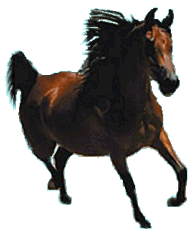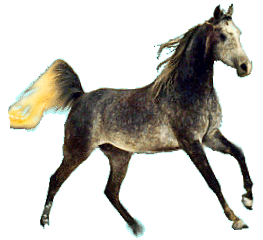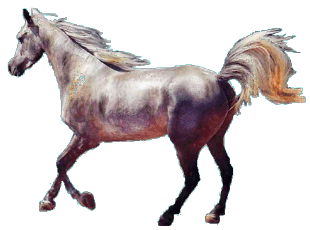|
|
ArabianThe Breed of Antiquity |
|
|
|
ArabianThe Breed of Antiquity |
|
 The familiar appearance and character the Arabian horse is considered the most beautiful of all. Carefully bred for thousands of years, the Arabian is the purest and oldest of all horse breeds. The Arabian has influenced the greater portion of the world's equine population. For example, the
Thoroughbred, which has an Arabian foundation, exceeds the Arab in size and speed, but the Arab is more sound and has more stamina than the Thoroughbred. The Arabian is so popular that there is a national breed society in nearly every country in the world.
The familiar appearance and character the Arabian horse is considered the most beautiful of all. Carefully bred for thousands of years, the Arabian is the purest and oldest of all horse breeds. The Arabian has influenced the greater portion of the world's equine population. For example, the
Thoroughbred, which has an Arabian foundation, exceeds the Arab in size and speed, but the Arab is more sound and has more stamina than the Thoroughbred. The Arabian is so popular that there is a national breed society in nearly every country in the world.
Even though its exact origin is unclear, artifacts from at least 2,500 years before Christ indicate a race of horses of fixed Arabian type in existence on the Arabian Peninsula. This "desert horse" is traced by its association to the Bedouin, who were the most intimately concerned with it. The Bedouin tenuously claim that around 3000 BC the mare, Baz, was captured in the Yemen by Bax, the great-grandson of Noah, tamer of the wild horses. Other claims of Arab origins say that the horse has been bred in Yemen since 5000 BC, or that Nejd, Saudi Arabia, was the main center of the Arab. Iranians also claim to be the first to domesticate the Arabian.
Other evidence points to the Arab's derivation from the proto-Arab type, believed to have come from America at a relatively early stage. This proto-Arab spread across temperate regions from East Asia to North Africa. This theory leads to a belief that the Arab's wild ancestor occupied a widespread habitat, which is supported by the discovery of bones similar to the modern Arab in Japan and Western Iran. These Arab-like bones date back to before the domestication of the horse, which indicates that they must have belonged to a wild horse. Arablike features in miniature are indicated in the Caspian horse/pony, which is descended from wild ponies near the Caspian Sea. There is some confusion as to whether the Caspian ponies descended from Arabs or vice-versa, but they apparently have similar heritage.
It is most likely that the Arabian has its own progenitor, separate from that Przewalksi's horse (of cold-bloods and ponies). It is also unlikely that the Arab could have originated from a small area of desert, but that it may have wandered over a wide area of the Near, Middle and Far East. There are many stories of Arabians, from that of Noah's great-grandson Baz to King Solomon, who ruled Israel from about 974 BC Solomon captured Arabs from Egypt and the Arabian deserts, and he is said to have had 1,200 riding horses and 40,000 chariot horses.
Muslim conquests began by the Prophet Mohammed in the 7th century AD made possibly the spread of this Arabian blood throughout the world. The Arabian became the foundation stone of Mohammed's campaign to expand the faith of Islam and his Muslim Empire. According to Islam, Allah was said to have created the horse, so those who looked after their horses were promised a life in paradise after death. This created incentives to breed and caress for horses and it helped to build a great Muslim cavalry with which to conquer all in its path as it moved through Egypt, North Africa, and across the Mediterranean into Spain and upward into France. As a result the desert horses spread through Iberia into Christian Europe. Many of these horses were left behind when the Muslims were eventually beaten and forced back to their homelands. The Arab was now left to influence the native breeds of Europe, and almost every modern breed has Arabian ancestors.
The aura of mystery and mysticism that surrounds this horse have woven a web of legends, one of which attributes the Arab to have descended from one of seven steeds. These seven ancestors are said to have been selected by King Solomon from the 40,000 chariot horses and 12,000 riding horses that he owned. The legend has it that seven breeds were subsequently produced from these seven steeds. These are - Koheilan (whose eyelids looked painted), Manaki (of the superb neck), Hedregi (energetic and tireless), Saklani (brave and intelligent), Gilfi (swift and powerful), Hedban (noble and valiant), and Trefi (proud).
 Another popular legend has it that the Arab descends from the five mares of Mohammed which were first brought to Mecca out of a total of 85 sent by the Prophet to bring news of the victory. There are three basic types of Arab, according to Raswaan - the Assil or Kocklani, the purebred Arab, and the Arab breed. The Assil came to be described by the different tribes as Kohuail, Koheil, Khamsa or Kamsat, and is said to be the true Bedouin Arab. The Assil is classified into three sub breeds, the Kuhailan (symbol of endurance), the Siglavy (the image of beauty and elegance), and the Muniqi (the ultimate expression of speed). When comparing with the others, the Muniqi tends to be more elegant in appearance with longer limbs, a longer neck and back, and a straight profile. The purebred Arab is said to be a result of crossing the three sub-breeds, and the Arab breed other horses whose precise origins are uncertain. The Arab breed may reflect influence of the Berber, the
Persian, the
Syrian, the
Egyptian Arab and other related breeds.
Another popular legend has it that the Arab descends from the five mares of Mohammed which were first brought to Mecca out of a total of 85 sent by the Prophet to bring news of the victory. There are three basic types of Arab, according to Raswaan - the Assil or Kocklani, the purebred Arab, and the Arab breed. The Assil came to be described by the different tribes as Kohuail, Koheil, Khamsa or Kamsat, and is said to be the true Bedouin Arab. The Assil is classified into three sub breeds, the Kuhailan (symbol of endurance), the Siglavy (the image of beauty and elegance), and the Muniqi (the ultimate expression of speed). When comparing with the others, the Muniqi tends to be more elegant in appearance with longer limbs, a longer neck and back, and a straight profile. The purebred Arab is said to be a result of crossing the three sub-breeds, and the Arab breed other horses whose precise origins are uncertain. The Arab breed may reflect influence of the Berber, the
Persian, the
Syrian, the
Egyptian Arab and other related breeds.
Considered the most beautiful of all horses, it has a long history of pure breeding which is probably responsible for its harmonious proportions and overall impression of balance. It most certainly has a harmony and elegance of the lines which make this breed indisputably beautiful. Unmistakable and unforgettable, the small head is short and of great refinement, the face pronouncedly concave or dished. The Arab has exceptionally large nostrils. The eyes are also exceptionally large, circular and expressive, and they are widely spaced and lower than in other breeds. The Arab's ears are small, alert, fine and sometimes curved inward. A notable feature of the Arab's head, unique among equines, is the 'jibbah,' which is a shield-shaped bulge positioned between the eyes and extending to the ears and nasal bone. The small, tapered muzzle has very soft skin, and he has thin lips. Its jowl is a deep and wide between the branches.
The long and arched neck of the Arabian has a distinctive feature called the 'mitbah,' which applies to the particular angle at which the head meets the neck resulting in a particular arched curve. This curve allows the head to turn in all directions freely. His long and sloping shoulders are distinctly set and the neck is curved gracefully into the rounded withers, which are not too prominent, but slope into the strong, level and short back. His shoulders are less sloped than other breeds. He has a broad and muscular chest and a deep girth.
Arabians have short, slightly concave backs with strong loins and a long and level croup. His abdomen is rather tucked up. The limbs are hard and clean, without excessive bone measurement below the knee of the forelimbs. His tendons are clearly defined, and each hard, round hoof, which rarely suffers from disease, is nearly perfect in shape and size. His knees and hocks should also be clearly defined, and the pasterns relatively long and sloping. For many years, the Arabian's hind legs were considered a failing, yet the breed is inherently sound and its movement remarkably free. His croup is long and level, and his quarters muscular. The Arab carries his tail well arched when in motion, which is emphasized by its high set position in the croup. This high carriage of the tail is attributed to the difference in conformation when comparing the Arab with other breeds. The Arab has 17 ribs, compared with 18 in other horses; 5 lumbar bones, where the others have 6; and only 16 tail vertebrae while the rest have 18 vertebrae in the tail. This unique skeletal formation governs the outline of the Arabian.
Naturally excelling at endurance riding, the Arab is outclassed in other competitive disciplines, yet it has been bred in great numbers all over the world. This is a rare dedication to the breed and the Arab still has an upgrading influence when crossing with other breeds. There are numerous record's of the Arab's legendary stamina and remarkable powers of endurance. Races were often held during the 19th century over long distances in the desert lasting for three days. The Arab's movement is as though the horse were traveling on springs and it is described as 'floating.' Though fiery and courageous, the Arabian also possess an exceptionally gentle nature. With his handsome appearance and action, it is no surprise that this beautiful and aristocratic breed is universally admired and highly valued. He is prized both as a purebred and for upgrading other breeds. The Arab has an aptitude as a riding horse and for light draft, with qualities of speed and endurance, and is gentle and undemanding, but with a high strung temperament.
 The Arab has stamina, grace, noble shape and outlook, adaptability, intelligence, soundness, longevity, fertility, prepotency and perceptiveness, all of which make it one of the world's most outstanding breeds. It is bred for beauty and its affectionate nature. The Arab has been shown, kept as a pet, ridden and raced. He moves proudly, his head and tail held high and his ear pricked. He takes free, straight strides when trotting, but his gallop is a natural pace. His free, fast strides take him floating across the ground and he has the stamina to maintain speed for exceptionally long periods of time.
The Arab has stamina, grace, noble shape and outlook, adaptability, intelligence, soundness, longevity, fertility, prepotency and perceptiveness, all of which make it one of the world's most outstanding breeds. It is bred for beauty and its affectionate nature. The Arab has been shown, kept as a pet, ridden and raced. He moves proudly, his head and tail held high and his ear pricked. He takes free, straight strides when trotting, but his gallop is a natural pace. His free, fast strides take him floating across the ground and he has the stamina to maintain speed for exceptionally long periods of time.
The classic Arabian comes in chestnut, gray, bay, and black coat colors. Today Arabians can be most strong solid colors, and now, more rarely, roan. Arabs have dark skin which is thin, elastic, and covered with short hairs, and the Arab's mane and tail are uniquely fine and silky. Ideally, the Arabian stands between 14.2 and 15 hands high, though some stand at only 14.1 hands. He weighs in at 840 to 990 pounds.
Historically, Napoleon's favorite charger was an Arab named Marengo, whom he rode at the Battle of Waterloo. Maregno was gray, and Napoleon encouraged the use of Arabians at national studs throughout France.
The most famous of the many lines within the Arabian breed is the desert stock, which is known as the Original or Elite Arab. These are bred by the Bedouin, who are nomadic tribesmen from Nejd. The Bedouin need a tough horse which will survive their rough, hard life, but they wanted it beautiful enough to be proud of. They used rigorously selective breeding methods for centuries in order to achieve their goals.
They tested the courage and stamina of the mares by using them in battles and for hunting. Stallions were chosen for their beauty, intelligence and conformation. Alien blood was not permitted, and pedigrees could be quoted by the owner back many generations. They practiced some in-breeding, which led to the prepotency of the most valued assets of stamina, soundness and beauty. While there are claims that the Bedouin tribesmen's rigorous methods of selective breeding developed the breed, there is evidence that the modern Arab has changed little from prehistoric times. That would mean that man really has had little influence on its build or shape.
For more information on Arabian horses from other parts of the world, visit:
The Original or
Elite Arabian
 For more information on Arabian horses, visit:
For more information on Arabian horses, visit:
Published December 1996 in NorthWest Breyer Horse Club Newsletter. (em)

© 1997-2007
NW Breyer Horse Club
& Refiner of Gold Creations
Equinealities in place since 1997,
Section in place 2001,
Updated 3/13/2007




